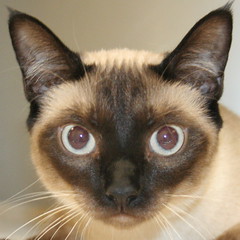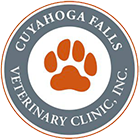|
Just like on the human side of medicine, animals can struggle with thyroid issues, too. Dogs tend to struggle with hypothyroidism, an under-production of thyroid hormone. Cats, on the other hand, deal more with hyperthyroidism, an over-production of thyroid hormone.
Revisiting the role of thyroid hormone, it’s job is to drive the metabolism of every cell in the body. For cats under a too-heavy influence of thyroid hormone, their cells, tissues, organs and bodies are working on overdrive. Their appetites can’t keep up with their metabolic rate. As a result, they lose weight despite an increased appetite. Cats can also experience hair loss, increased thirst and urination, and persistently restless activity.
For most cats, the problem is not a malignancy, but an over-abundance of normal thyroid tissue, called hyperplasia. This extra tissue kicks out extra thyroid hormone and is not responsive to signals that tell it to reign in its hormone production. It is rare for a cat to have a malignant cancer of a thyroid gland.
|
What should you do when you see your cat behaving differently or seemingly eating you out of your house but failing to gain weight? Talk with your veterinarian, and follow his/her advice when they suggest measuring a thyroid level. For most cats this will be a simple blood test. A small population of cats can be a bit tricky to diagnose because they’ll actually have a normal initial test (a test that measures a form of thyroid hormone called T4). In those instances where the T4 measures normally but the patient has a number of symptoms, more specialized, advanced blood tests can be performed.
The good news is that feline hyperthyroidism is very treatable! The options for treatment include:
(1) Diet therapy. Hill’s Prescription Diets recently introduced y/d, a diet that limits the amount of iodine. Many cats return to normal thyroid function after a couple of weeks on y/d. And because it is a complete and balanced diet, kitties can be fed y/d indefinitely.
Cons: Once in a while there is a cat that doesn’t like the diet. Prescription diets are more costly than OTC/maintenance diets and follow-up blood testing is necessary at intervals.
Pros: You have to feed your cat anyway, so if your cat’s food can also cure the disease, what’s not to like?
(2) Medical therapy.
Cons: Some cats do not take oral medication well, and there are potential side-effects of the medication such as vomiting and/or extreme facial itchiness. Follow-up blood testing is necessary at intervals.
Pros: Gastrointestinal medications is a good option for many cats because it the medication is inexpensive and follow-up blood testing is not terribly costly. It is also a reversible form of therapy.
Why would a reversible treatment be desirable? One of the tricky things with hyperthyroidism is that it can mask kidney disease. When unhealthy kidneys are forced to work on overdrive by an overactive thyroid gland, kidney function can look normal. So whenever we first diagnose a cat with hyperthyroidism, we first reach for diet therapy or medical therapy because if kidney disease is unmasked, we can back off of treatment a bit and work to find a good balance between managing the hyperthyroidism and not allowing kidney disease to take too much of a toll.
If we determine that a kitty with a well-controlled thyroid level also has appropriate kidney levels, we can think about one of the two permanent treatment options.
(3) Surgical therapy. For cats that have one enlarged thyroid gland and one normal thyroid gland, the abnormal gland can be removed, and the remaining gland can supply the body with all of its thyroid needs.
Cons: Surgical therapy involves general anesthesia and a surgical recovery; it is also significantly more costly than diet or medical therapy.
Pros: Usually a definitive treatment. Follow-up blood testing is rarely necessary. There is no need to give oral medication following surgery. One round of follow-up blood testing is usually all that is necessary.
(4) I131 (a.k.a. Radioactive Iodine) Therapy. Borrowed from the human side of medicine, this treatment utilizes the truth that only the abnormal thyroid tissue takes up the radioactive iodine. This kills the abnormal tissue and spares all of the normal tissue.
Cons: The most costly of the four options. For treatment, cats must stay at a referral clinic/hospital for a number of days.
Pros: Definitive treatment and the vast majority of cats require only one treatment. General anesthesia and surgical recovery are off of the table. One round of follow-up blood testing is usually all that is necessary.
Usually in medicine, if there is more than one treatment option then none of them are likely an optimal choice. The treatment options for feline hyperthyroidism do not fit with this idea, though, because all of the treatment options have their place, and they’re all different enough that one or more is usually a good option for each individual kitty.
When we diagnose one of our patients with hyperthyroidism, we take the time to not only review these options with our clients in a general, academic sense, but we also take the time to work with our clients to choose the best treatment for their kitty. We welcome to opportunity to provide you with good health care options, and you can set up a time to meet with one of our doctors by calling 330-929-3223.



